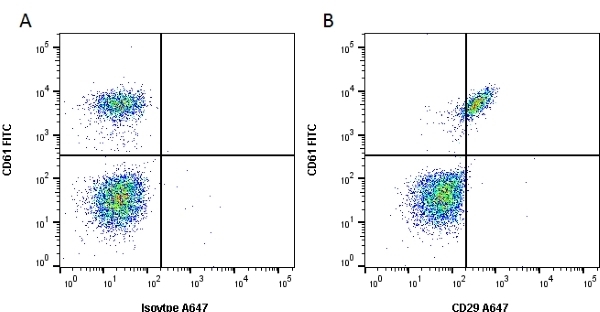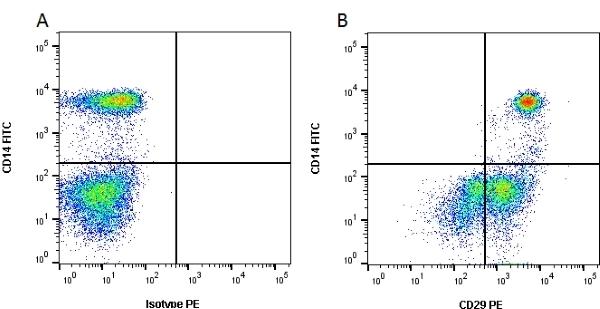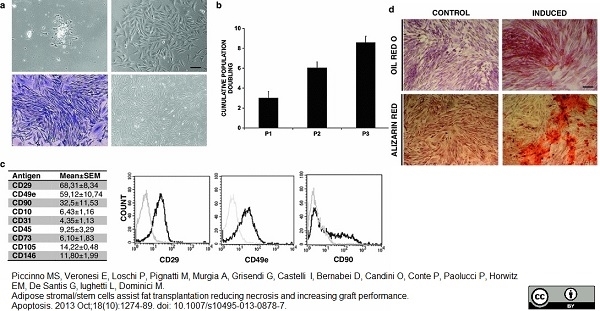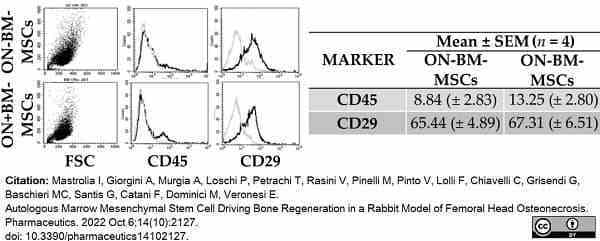CD29 antibody | 12G10





Mouse anti Human CD29:RPE
- Product Type
- Monoclonal Antibody
- Clone
- 12G10
- Isotype
- IgG1
- Specificity
- CD29
| Mouse anti Human CD29 monoclonal antibody, clone 12G10 recognizes human CD29 also known as beta1 integrin or VLA-4 subunit alpha. CD29 is a ~130 kDa under reducing, ~115 kDa under non-reducing conditions single pass type I transmembrane glycoprotein. CD29 acts as the common beta subunit of the heterodimeric very late antigens 1-6, complexing with CD49a-f respectively where it forms part of the receptors for laminin , collagen and fibronectin. the VLA heterodimers mediate cell-cell and cell-matrix interactions. Mouse anti Human CD29, clone 12G10 binding to cells adhering via VLA-4 results in actin cytoskeletal disruption and subsequent inhibition of attachment and spreading whilst 12G10 binding to cells adhering via VLA-5 results in enhancement of both these processes (Humphries et al. 2005). Clone 12G10 enhances alpha 5 beta 1-fibronectin interactions and binds to a region of CD25 containing the binding epitopes of several other anti CD29 antibody clones. However, unlike these, binding of 12G10 is enhanced in the presence of ligands such as fibronectin fragments (Mould et al. 1995). Binding of antibody clone 12G10 to the integrin β1 subunit is affected by divalent cations and the binding epitope appears to be located around residues 207-218 in the b1 subunit putative A-domain (Mould et al. 1998). |
- Target Species
- Human
- Species Cross-Reactivity
-
Target Species Cross Reactivity Rat Mouse Mink Rabbit - N.B. Antibody reactivity and working conditions may vary between species.
- Product Form
- Purified IgG conjugated to R. Phycoerythrin (RPE) - lyophilized
- Reconstitution
- Reconstitute with 1.0 ml distilled water.
Care should be taken during reconstitution as the protein may appear as a film at the bottom of the vial. Bio-Rad recommend that the vial is gently mixed after reconstitution. - Preparation
- Purified IgG prepared by affinity chromatography on Protein A from tissue culture supernatant
- Buffer Solution
- Phosphate buffered saline
- Preservative Stabilisers
- 0.09% sodium azide (NaN3)
1% bovine serum albumin
5% sucrose - Immunogen
- Purified human beta1 integrin preparation from HT1080 fibrosarcoma cell extract
- Fusion Partners
- Spleen cells from an immunised BALB/c mice were fused with cells of the X63/Ag8.653 mouse myeloma cell line
- Regulatory
- For research purposes only
- Guarantee
- 12 months from date of despatch
After reconstitution store at +4°C.
DO NOT FREEZE.
This product should be stored undiluted. This product is photosensitive and should be protected from light.
| Application Name | Verified | Min Dilution | Max Dilution |
|---|---|---|---|
| Flow Cytometry | Neat |
How to Use the Spectraviewer
Watch the Tool Tutorial Video ▸- Start by selecting the application you are interested in, with the option to select an instrument from the drop down menu or create a customized instrument
- Select the fluorophores or fluorescent proteins you want to include in your panel to check compatibility
- Select the lasers and filters you wish to include
- Select combined or multi-laser view to visualize the spectra
| Description | Product Code | Applications | Pack Size | List Price | Your Price | Quantity | |
|---|---|---|---|---|---|---|---|
| Mouse IgG1 Negative Control:RPE | MCA928PE | F | 100 Tests | Log in | |||
| List Price | Your Price | ||||||
| Log in | |||||||
| Description | Mouse IgG1 Negative Control:RPE | ||||||
| Description | Product Code | Applications | Pack Size | List Price | Your Price | Quantity | |
|---|---|---|---|---|---|---|---|
| Human Seroblock | BUF070A | F | 50 Test | Log in | |||
| List Price | Your Price | ||||||
| Log in | |||||||
| Description | Human Seroblock | ||||||
| Human Seroblock | BUF070B | F | 200 Test | Log in | |||
| List Price | Your Price | ||||||
| Log in | |||||||
| Description | Human Seroblock | ||||||
Source Reference
-
Mould, A.P. et al. (1995) Identification of a novel anti-integrin monoclonal antibody that recognises a ligand-induced binding site epitope on the beta 1 subunit.
FEBS Lett. 363 (1-2): 118-22.
References for CD29 antibody
-
Mould, A.P. et al. (1995) Regulation of integrin alpha 5 beta 1 function by anti-integrin antibodies and divalent cations.
Biochem Soc Trans. 23 (3): 395S. -
Zhong, C. et al. (1998) Rho-mediated contractility exposes a cryptic site in fibronectin and induces fibronectin matrix assembly.
J Cell Biol. 141: 539-51. -
Mould, A.P. et al. (1998) Regulation of integrin function: evidence that bivalent-cation-induced conformational changes lead to the unmasking of ligand-binding sites within integrin alpha5 beta1.
Biochem J. 331 ( Pt 3) (Pt 3): 821-8. -
Iba, K. et al. (2000) The cysteine-rich domain of human ADAM 12 supports cell adhesion through syndecans and triggers signaling events that lead to beta1 integrin-dependent cell spreading.
J Cell Biol. 149: 1143-56. -
Whittard, J.D. and Akiyama, S.K. (2001) Positive regulation of cell-cell and cell-substrate adhesion by protein kinase A.
J Cell Sci. 114: 3265-72. -
Thodeti, C.K. et al. (2003) ADAM12/syndecan-4 signaling promotes beta 1 integrin-dependent cell spreading through protein kinase Calpha and RhoA.
J Biol Chem. 278: 9576-84. -
Kawaguchi, N. et al. (2003) ADAM12 induces actin cytoskeleton and extracellular matrix reorganization during early adipocyte differentiation by regulating beta1 integrin function.
J Cell Sci. 116: 3893-904. -
Newsome, P.N. et al. (2004) Serum from patients with fulminant hepatic failure causes hepatocyte detachment and apoptosis by a beta(1)-integrin pathway.
Hepatology. 40: 636-45.
View The Latest Product References
-
Loughran, G. et al. (2005) Mystique is a new insulin-like growth factor-I-regulated PDZ-LIM domain protein that promotes cell attachment and migration and suppresses Anchorage-independent growth.
Mol Biol Cell. 2005 Apr;16(4):1811-22. -
Meng, X. et al. (2005) Evidence for the presence of a low-mass beta1 integrin on the cell surface.
J Cell Sci. 118: 4009-16. -
Lee, H. et al. (2006) A critical role for the membrane-type 1 matrix metalloproteinase in collagen phagocytosis.
Mol Biol Cell. 17: 4812-26. -
Aasted, B. et al. (2007) Reactivity of monoclonal antibodies to human CD antigens with cells from mink.
Vet Immunol Immunopathol. 119: 27-37. -
Jović, M. et al. (2007) EHD1 regulates beta1 integrin endosomal transport: effects on focal adhesions, cell spreading and migration.
J Cell Sci. 120: 802-14. -
Zhou, J. et al. (2008) Salvicine inactivates beta 1 integrin and inhibits adhesion of MDA-MB-435 cells to fibronectin via reactive oxygen species signaling.
Mol Cancer Res. 6: 194-204. -
Sodek, K.L. et al. (2009) Compact spheroid formation by ovarian cancer cells is associated with contractile behavior and an invasive phenotype.
Int J Cancer. 124: 2060-70. -
Matthews,B.D. et al. (2010) Ultra-rapid activation of TRPV4 ion channels by mechanical forces applied to cell surface [beta]1 integrins.
Integr Biol (Camb). 2: 435-42. -
Gravelle, S. et al. (2010) Up-regulation of integrin expression in lung adenocarcinoma cells caused by bacterial infection: in vitro study.
Innate Immun. 2010 Feb;16(1):14-26. -
Werner, J. et al. (2012) Expression of integrins and Toll-like receptors in cervical cancer: Effect of infectious agents.
Innate Immun. 18: 55-69. -
Piccinno, M.S. et al. (2013) Adipose stromal/stem cells assist fat transplantation reducing necrosis and increasing graft performance.
Apoptosis. 18 (10): 1274-89. -
Lee, J. et al. (2013) Phloridzin isolated from Acanthopanax senticosus promotes proliferation of α6 integrin (CD 49f) and β1 integrin (CD29) enriched for a primary keratinocyte population through the ERK-mediated mTOR pathway.
Arch Dermatol Res. 305 (8): 747-54. -
Rodriguez-Teja, M. et al. (2015) AGE-modified basement membrane cooperates with Endo180 to promote epithelial cell invasiveness and decrease prostate cancer survival.
J Pathol. 235 (4): 581-92. -
Xie, G. et al. (2021) Characterization of HIV-induced remodeling reveals differences in infection susceptibility of memory CD4+ T cell subsets in vivo.
Cell Rep. 35 (4): 109038. -
Mastrolia, I. et al. (2022) Autologous Marrow Mesenchymal Stem Cell Driving Bone Regeneration in a Rabbit Model of Femoral Head Osteonecrosis.
Pharmaceutics. 14(10):2127.
MCA2028PE
If you cannot find the batch/lot you are looking for please contact our technical support team for assistance.
Please Note: All Products are "FOR RESEARCH PURPOSES ONLY"
View all Anti-Human ProductsAlways be the first to know.
When we launch new products and resources to help you achieve more in the lab.
Yes, sign me up



